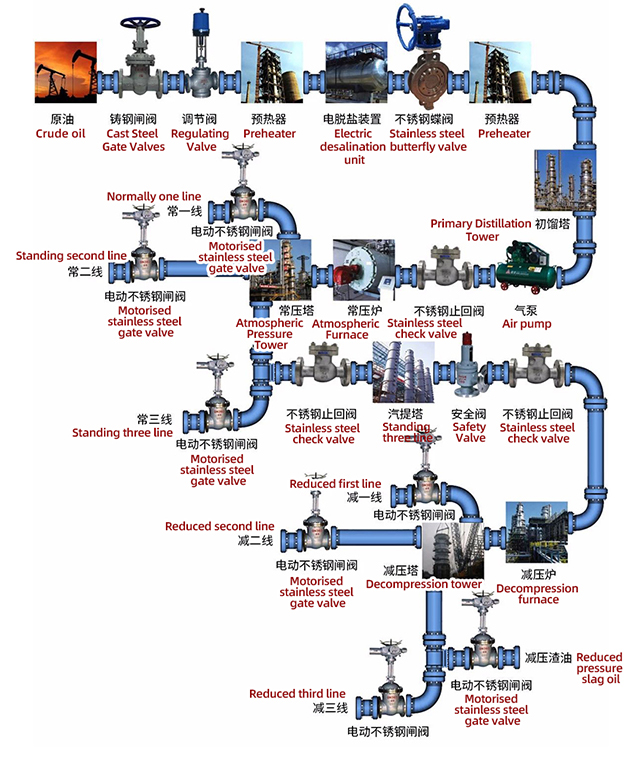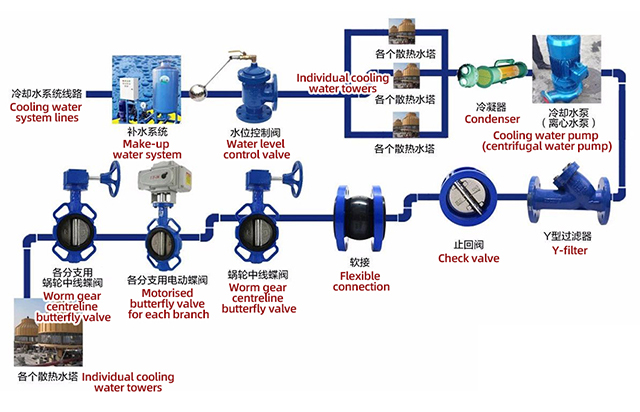- Gate valve
-
- DN1000 Extension stem double flange soft seal gate valveDIN F4 resilient seated gate valveDN450-1200 Resilient Seated Gate ValveDIN F5 resilient seated gate valveSocket connection soft seal gate valveUnderground cap soft seal gate valveBS5163 rising stem soft seal gate valveHard seal gate valveAPI slab Gate ValveStainless steel flange gate valveWafer knife gate valvePneumatic gate valveSoft seal gate valveExtension stem gate valveUL/FM fire protection groove ends gate valveRising stem forged steel gate valvecarbon steel gate valveStainless steel threaded gate valveDIN soft seal gate valveANSI soft sealing gate valve 200PSICast iron gate valveBS resilient seated gate valve
- Butterfly valve
-
- DN900 pneumatic triple eccentric hard seal butterfly valveD643H Triple Eccentric Butterfly ValveD343H Hard seal butterfly valveMulti standard EPDM seated butterfly valveSingle flange butterfly valveDN2000 Double eccentric butterfly valveFlange butterfly valveLug butterfly valveWafer butterfly valve with handleWorm gear operated butterfly valveWafer lined fluorine butterfly valveStainless steel wafer butterfly valveStainless steel flanged butterfly valveThree eccentric flange butterfly valvePneumatic flanged butterfly valvePneumatic wafer butterfly valveTriple eccentric butterfly valve wafer typeWafer butterfly valve ULC approvedInflatable seat butterfly valveHigh performance butterfly valveGrooved end butterfly valveElectric soft seal butterfly valveFlange fluorine lined butterfly valveHandle aluminum butterfly valveWorm Gear Aluminum Butterfly ValveFull PTFE lined butterfly valve wafer typeOne stem no-pin wafer butterfly valveMulti standard aluminum stem butterfly valveStainless Steel wafer Butterfly ValveAluminium handle operated lug butterfly valveLever Operated Flange Butterfly ValveButterfly valve stemButterfly valve discButterfly valve seat
- Ball valve
-
- DN1400 top-mounted eccentric semi-ball valveFlanged three-way ball valveFully welded ball valveNatural gas ball valveHigh platform flange ball valve1 PC ball valveFixed ball valvePTFE seat flanged ball valveMetal seat ball valveAPI 6D ball valve3 Piece ball valveFull Bore 3 way ball valve L-Port3 Way T-Port ball valve2PC Ball valve female thread stainless steel
- Globe Valve
-
- API Carbon Steel Globe ValveBellows Globe ValveStainless steel flange globe valveStainless steel thread S type globe valveStainless steel thread B type globe valveCast Steel Globe ValvePiston Globe ValveWCB Carbon Steel Globe Check Valveelectric motorized control stainless steel SS316 globe valveBrass Globe ValveCryogenic Globe valveHT200 Globe ValveThreaded Stainless Steel Globe ValveGG25 Globe ValveANSI API Cast Steel And Stainless Steel Globe valve
- Check valve
-
- Rubber seal check valveDN800 Slow closing check valveDN800 Rubber Disc Check ValveButterfly Buffering Check Valvecheck valve with counter weightSilent Check ValveWCB Swing check valveSwing Check ValveSingle Chip Check Valve H74WStainless Steel Wafer Check ValveSwing Start Check ValveFoot check valveAPI Swing Check ValveDIN Flange check valveSingle plate check valveLifting Check ValveBottom ValveHammer Diminish Noises Check ValveWafer Check ValveWafer dual plate check valve
- Control valve
-
- Static Balancing ValveCage Guided Sleeve Globe Control ValveDN1000 Piston Flow Regulating ValveDN1600 Electric Actuator Flow Regulating ValvePneumatic Flanged Butterfly ValvePneumatic Wafer Butterfly ValveAngle Seat ValvePneumatic gate valveElectric three-way control valveElectric sleeve control valve
- Water Meter
-
- Vertical Type Water MetersStainless steel threaded water meterPiston water meterPlastic water meterMore flow rotor dry water meterspiral vane flange water meterCI wotlman water meter with pulse outputLXCLG(R) Vertical removable element woltman cold (hot) water meterSingle flow rotor dry water meterPrepaid Token Water MeterElectromagnetic flowmeterRotary Piston Liquid Sealed Water MeterRotary Piston Liquid Sealed Water Meter
- Air valve
-
- Double ball exhaust valveDoubleair Air Valve SaudiDoubleair Air Valve Southeast AsiaDoubleair Air Valve South AmericaDouble Air ValveThreaded Air ValveSingle Air ValveTriple Functions Air ValveAutomatic Air Release ValveAutomatic release valveAutomatic exhaust valveComposite Exhaust Air ValveBrass exhaust valveDouble Ball Air Valve
- Pipe Repair & Coupling
-
- Flexible Multi-Function Pipe Coupling ZFJ-SSS Semi-Circle Pipe Repair Clamp SJW-HDuctile Iron Band Repair ClampStainless Steel Band Repair ClampDouble-Section Pipe Repair CouplingFolding Type Pipe RepairSingle-Section Multi-Function Pipe Coupling MF-SGear-Ring Type Multi-Function Pipe Coupling GR-SZBW Damping Corrugated Hose
- Dismantling Joint
-
- VSSJAFC(CC2F) Detachable Flange Transmission JointVSSJA-2(B2F) Double Flange Limited Expansion JointVSSJA-1(BF) Single Flange Limited Expansion JointVSSJA(AF) Flange Loose Expansion JointJGD-B Threaded Rubber JointZBW Damping Corrugated HoseKXT-S Flexible Dual-Spherical Rubber JointKXT Rubber Soft JointFlange Adaptor
What valves are used in a refinery vacuum distillation system?
Refining units in petrochemical industry are used to process crude oil to produce different types of fuel oils such as gasoline, diesel, kerosene, lubricating oil and chemical raw materials. The units mainly include atmospheric and vacuum units, catalytic cracking units, catalytic reforming units, delayed coking units, hydrocracking units and hydrofining units, etc.
1. Crude oil electric desalination:
Crude oil enters the device through the oil pipeline, because the crude oil contains salt and water. Therefore, valves with anti-corrosion performance should be used. Crude oil enters the heat exchanger at room temperature, mixes with demulsifier and deionized water, and exchanges heat to 120°C-140°C through the heat exchanger. After desalination, the heat is exchanged through a heat exchanger to 180°C-230°C and then sent to the initial distillation tower.
2. Initial distillation tower:
The purpose of initial distillation is to produce reformed feedstock with low arsenic content, and to resist fluctuations in crude oil composition and water content fluctuations for the operation of atmospheric and vacuum towers. Part of the gasoline is distilled from the top of the tower. The outflow temperature of the initial distillation column product is 170°C-220°C, and after heat exchange, it reaches 290°C-308°C and enters the atmospheric furnace.
Heat to 360°C-370°C.
4. Atmospheric tower:
The components heated in the atmospheric pressure furnace enter the atmospheric column for distillation, gasoline (40-120°C), kerosene (110-350°C), light diesel oil (180-370°C), heavy diesel oil (350-410°C) and atmospheric pressure Residual oil (outlet temperature 340°C).
5. Decompression furnace:
Heat to 380°C-420°C.
6. Vacuum tower:
Atmospheric pressure residue enters the vacuum tower through heat exchange, and the top of the vacuum tower is gas, top-reducing oil and water (90-250°C fraction), measuring line: minus one line (diesel component 210-350°C fraction), minus two lines (wax oil component 280-520°C fraction), minus the third line (wax oil component 330-540°C fraction) is heavier than minus the second line. Some have reduced the fourth line (heavy wax oil), and generally do not put it outside. Bottom of the tower: Vacuum residue minus fourth line and bottom bottom residue can be used as feedstock for catalytic cracking, and can also be used as raw material for asphalt.
Gate valves (PN1.6, PN2.5, PN4.0, PN6.3, mainly made of carbon steel, stainless steel, alloy steel);
Globe valve (PN1.6, PN2.5, PN4.0, PN6.3, mainly made of carbon steel, stainless steel, alloy steel);
Ball valve (PN1.6, PN2.5, mainly made of carbon steel);
Butterfly valve (, PN2.5, mainly made of carbon steel);
Two-way butterfly valve (PN1.6, mainly made of carbon steel);









